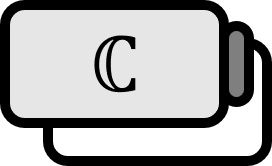다가함수의 이상적분
빌드업 1
다가함수를 적분할 때의 가장 큰 문제점은 경로를 지나면서 분기선을 만나면 함수값이 원치 않게 바뀐다는 것이다. 이러한 함수를 적분할 땐 이제까지 해왔던 것과 마찬가지로 경로 자체가 분기선을 우회하도록 하는 트릭을 사용한다.

대표적인 다가함수인 로그 $\log$ 를 생각해보면, 음의 실수축이 분기선이고 원점이 분기점이므로 위와 같은 경로를 생각해볼 수 있다. 그러면 $$ R \to \infty \\ r \to 0 $$ 이면서 $L_{1}$ 과 $L_{2}$ 이 음의 실수축으로 가까워질 때 복소평면 전체에서 유수정리를 사용할 수 있게 된다. 언뜻 들으면 정말 그래도 되는가 싶을 정도로 강력한 아이디어이니만큼 이제까지 배워온 모든 방법들이 총동원된다.
예제 1
예제로써 $\displaystyle \int_{0}^{ \infty } {{\text{Log} x} \over {x^2 + a^2}} dx$ 의 값을 구해보자.
풀이
적분경로 $\mathscr{C}$ 를 아래 그림과 같이 두자.

그러면 피적분 함수 $\displaystyle f(z) := {{\log z } \over {z^2 + a^2}}$ 에 대해 $$ \int_{\mathscr{C}} f(z) dz = {\color{red} \int_{\Gamma} f(z) dz } + \int_{L_{0}} f(z) dz + \color{blue} { \int_{\gamma} f(z) dz } + \int_{r}^{R} f(x) dx $$ $L_{0}$ 상에서 $z = \rho e^{ i \theta }$ 로 치환하면 $$ \int_{\mathscr{C}} f(z) dz = \int_{ R }^{r} { {(\text{Log} \rho + i \theta ) e^{i \theta } } \over {\rho^2 e^{2 i \theta } +a^2} } d \rho + {\color{red} \int_{\Gamma} f(z) dz } + \color{blue} { \int_{\gamma} f(z) dz } + \int_{r}^{R} {{\text{Log} x } \over {x^2 + a^2}} dx $$ 이제 $\theta$ 가 $\pi$ 에 가까워질 수록 $L_{0}$ 가 음의 실수축으로 가까워지므로, $\theta \to \pi$ 를 취하면 $$ \int_{\mathscr{C}} f(z) dz = \int_{ R }^{r} { { -( \text{Log} \rho + i \pi ) } \over {\rho^2 +a^2} } d \rho + {\color{red} \int_{\Gamma} f(z) dz } + \color{blue} { \int_{\gamma} f(z) dz } + \int_{r}^{R} {{\text{Log} x } \over {x^2 + a^2}} dx $$
발산하는 반원 상의 복소경로적분: 함수 $f$ 가 반지름이 $R$ 이고 중심이 $0$ 인 반원 $ \Gamma $ 상에서 연속이고 $\displaystyle \lim_{z \to \infty } z f(z) = 0$ 이라고 하면 $$\lim_{R \to \infty} \int_{\Gamma} f(z) dz = 0$$
한편 $$ \lim_{z \to \infty} z f(z) = \lim_{z \to 0} {{1} \over {z}} f(1/z) = \lim_{z \to 0} {{- \text{Log} z } \over { 1/z + a^2 z }} = \lim_{z \to 0} {{ - z } \over {a^2 z^2 -1 }} = 0 $$ 이므로 $$ \lim_{R \to \infty} {\color{red} \int_{\Gamma} f(z) dz } = 0 $$
수축하는 반원 상의 복소경로 적분: 함수 $f$ 가 반지름이 $r$ 이고 중심이 $0$ 인 반원 $ \gamma $ 상에서 연속이고 $\displaystyle \lim_{z \to 0 } z f(z) = 0$ 이라고 하면 $$\lim_{r \to 0} \int_{\gamma} f(z) dz = 0$$
그리고 $$ \lim_{z \to 0} z f(z) = \lim_{z \to 0} {{ \text{Log} z } \over { z + a^2 / z }} = \lim_{z \to 0} {{ 1 / z } \over { 1 - a^2 / z^2 }} = 0 $$ 이므로
$$ \lim_{r \to 0 } \color{blue} { \int_{\gamma} f(z) dz } = 0 $$ 따라서 $r \to 0$ 와 $R \to \infty$ 을 취하면 $$ \begin{align*} \int_{\mathscr{C}} f(z) dz =& \int_{ \infty }^{0} { { -( \text{Log} \rho + i \pi ) } \over {\rho^2 +a^2} } d \rho + \int_{0}^{\infty} {{\text{Log} x } \over {x^2 + a^2}} dx \\ =& \int_{ 0}^{ \infty } { { \text{Log} \rho } \over {\rho^2 +a^2} } d \rho + \int_{ 0}^{ \infty } { { i \pi } \over {\rho^2 +a^2} } d \rho + \int_{0}^{\infty} {{\text{Log} x } \over {x^2 + a^2}} dx \\ =& 2 \int_{0}^{\infty} {{\text{Log} x } \over {x^2 + a^2}} dx + i \int_{ 0}^{ \infty } { { \pi } \over {\rho^2 +a^2} } d \rho \end{align*} $$
유수 정리: 해석적인 함수 $f: A \subset \mathbb{C} \to \mathbb{C}$ 가 단순폐경로 $\mathscr{C}$ 내부의 유한한 특이점 $z_{1} , z_{2} , \cdots , z_{m}$ 를 가진다고 하자. 그러면 $$\int_{\mathscr{C}} f(z) dz = 2 \pi i \sum_{k=1}^{m} \text{Res}_{z_{k}} f(z)$$
유수 정리에 의해 $$ \int_{\mathscr{C}} f(z) dz = 2 \pi i \text{Res}_{a i} f(z) = 2 \pi i {{\text{Log} a i } \over {2 a i}} = \pi {{\text{Log} a + i {{\pi} \over {2}} } \over {a}} = {{ \pi \text{Log} a } \over {a}} + { i {{\pi^2} \over {2a} }} $$ 정리하면 $$ 2 \int_{0}^{\infty} {{\text{Log} x } \over {x^2 + a^2}} dx + i \int_{ 0}^{ \infty } { { \pi } \over {\rho^2 +a^2} } d \rho = {{ \pi \text{Log} a } \over {a}} + { i {{\pi^2} \over {2a} }} $$ 위 등식에서 실수부만 취하면 $$ \int_{0}^{\infty} {{\text{Log} x } \over {x^2 + a^2}} dx = {{ \pi \text{Log} a } \over {2a}} $$

 저희들의 저서 「줄리아 프로그래밍」이 2024 세종도서 학술부문에 선정되었습니다!
저희들의 저서 「줄리아 프로그래밍」이 2024 세종도서 학술부문에 선정되었습니다!

